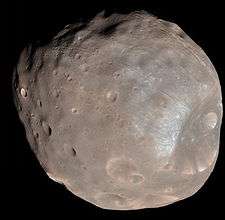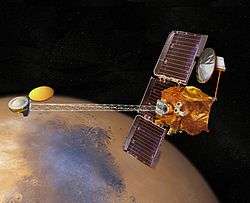Martian Moons Exploration
| Mission type | Sample return |
|---|---|
| Operator | ISAS / JAXA |
| Website |
mmx |
| Mission duration | ~5 years (planned) |
| Spacecraft properties | |
| Manufacturer | JAXA |
| Start of mission | |
| Launch date | September 2024 (planned)[1] |
| Phobos lander | |
| Landing date | March 2025[1] |
| Return launch | August 2028[1] |
| Sample mass | ≥10 g (0.35 oz)[2] |
The Martian Moons Exploration (MMX) is a robotic space probe set for launch in 2024 to bring back the first samples from Mars' largest moon Phobos.[1][3] Developed by the Japanese Aerospace Exploration Agency (JAXA) and announced in 9 June 2015, MMX will land and collect samples from Phobos once or twice, along with conducting Deimos flyby observations and monitoring Mars' climate.[4][5]
The mission aims to provide key information to help determine whether the Martian moons are captured asteroids or the result of a larger body hitting Mars.
Overview

The spacecraft will enter orbit around Mars, then transfer to Phobos,[6] and land once or twice and gather sand-like regolith particles using a simple pneumatic system.[7] The lander mission aims to retrieve a minimum 10 g (0.35 oz) of samples.[2][8] The spacecraft will then take off from Phobos and make several flybys of the smaller moon Deimos before sending the Sample Return Capsule back to Earth, arriving in July 2029.[6][1]
The mission leader is Yasuhiro Kawakatsu.
International collaboration
NASA, ESA, and CNES[9] are also participating in the project, and will provide scientific instruments.[10][11] The U.S. will contribute a neutron and gamma-ray spectrometer called MEGANE (an acronym for Mars-moon Exploration with GAmma rays and NEutrons, which also means "eyeglasses" in Japanese),[6][12] and France (CNES) the Near IR Spectrometer (NIRS4/MacrOmega).[8][13] France is also contributing expertise in flight dynamics to plan the mission's orbiting and landing manoeuvres.[7]
Development and testing of key components, including the sampler, is ongoing.[14] As of 2017, MMX is scheduled to be launched in 2024, and will return to Earth five years later.[8]
Scientific payload
The scientific payload consists on Japanese and international contributions. They will be powered by solar arrays.[1]
- Gamma ray and Neutron Spectrometer (MEGANE) - developed by NASA, USA
- Wide Angle Multiband Camera (WAM)
- Near-Infrared Spectrometer (MacrOmega) - developed by CNES, France.
- Telescopic Camera (TL)
- Light Detection and Ranging (LIDAR)
- Circum-Martian Dust Monitor (CMDM)
- Mass Spectrum Analyzer (MSA)
- Deployable Camera (DCAM5)
Additionally, the Gravity GradioMeter (GGM), Laser-Induced Breakdown Spectroscope (LIBS), Mission Survival Module (MSM) are proposed as additional instruments.[15] The CNES team is also conducting a study of the feasibility of including a small rover.[7]
Sampling
For sample collection, the mission opted to use an air gun to puff pressurised gas, pushing about 10 grams of soil into the sample container.[16] The spacecraft will then take off from Phobos and make several flybys of the smaller moon Deimos before sending the Sample Return Capsule back to Earth, arriving in July 2029.[6][1]
See also
- Proposed missions to Mars' moons
References
- 1 2 3 4 5 6 7 MMX Homepage. JAXA, 2017
- 1 2 Gravity both too strong and too weak: landing on the Martian moons. JAXA News. 31 August 2017
- ↑ "JAXA plans probe to bring back samples from moons of Mars". 10 June 2015 – via Japan Times Online.
- ↑ "Observation plan for Martian meteors by Mars-orbiting MMX spacecraft" (PowerPoint). June 10, 2016. Retrieved 2017-03-23.
- ↑ "A giant impact: Solving the mystery of how Mars' moons formed". ScienceDaily. July 4, 2016. Retrieved 2017-03-23.
- 1 2 3 4 NASA confirms contribution to Japanese-led Mars mission. Stephen Clark, Space Flight Now. 20 November 2017.
- 1 2 3 How to find the best samples on a moon: Building relationships and solving engineering challenges in France. JAXA News, 4 December 2017.
- 1 2 3 Fujimoto, Masaki (January 11, 2017). "JAXA's exploration of the two moons of Mars, with sample return from Phobos" (PDF). Lunar and Planetary Institute. Retrieved 2017-03-23.
- ↑ "Coopération spatiale entre la France et le Japon Rencontre à Paris entre le CNES et la JAXA-ISAS" (PDF) (Press release) (in French). CNES. February 10, 2017. Retrieved March 23, 2017.
- ↑ "ISASニュース 2017.1 No.430" (PDF) (in Japanese). Institute of Space and Astronautical Science. 22 January 2017. Retrieved 2016-03-23.
- ↑ Green, James (June 7, 2016). "Planetary Science Division Status Report" (PDF). Lunar and Planetary Institute. Retrieved 2017-03-23.
- ↑ Back to the Red Planet. Johns Hopkins APL. 17 November 2017.
- ↑ "A STUDY OF NEAR-INFRARED HYPERSPECTRAL IMAGING OF MARTIAN MOONS BY NIRS4/MACROMEGA ONBOARD MMX SPACECRAFT" (PDF). Lunar and Planetary Institute. March 23, 2017. Retrieved 2017-03-23.
- ↑ "ISASニュース 2016.7 No.424" (PDF) (in Japanese). Institute of Space and Astronautical Science. 22 July 2016. Retrieved 2017-03-23.
- ↑ Ozaki, Masanobu; Shiraishi, Hiroaki; Fujimoto, Masaki (5 January 2017). "火星衛星探査計画(MMX)の科学観測装置" (in Japanese). JAXA. Retrieved 2017-07-12.
- ↑ Preparing for the unexpected: a second way to sample a moon. Yasutaka Satou, JAXA News. 25 October 2017.

.jpg)
.jpg)